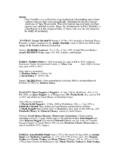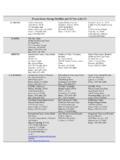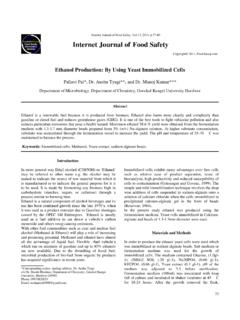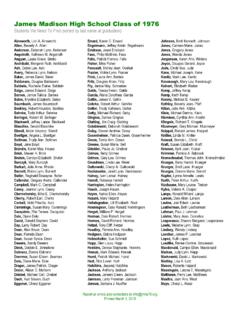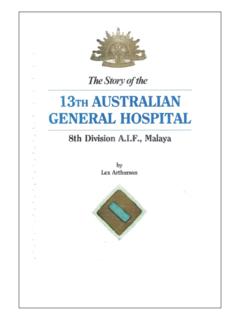Transcription of Aquaculture zoning, site selection and area …
1 FOOD AND AGRICULTURE ORGANIZATION OF THE UNITED NATIONS/ THE WORLD BANKRome, 2017 Aquaculture zoning , site selection and area management under the ecosystem approach to aquacultureA handbookCover photograph:Oyster culture in Chanthaburi, ThailandMolluscs feed low on the food chain, which make them a relatively cheap source of protein. Culture plots canbe established and managed by individual farmers, a cluster of farmers, or the community. This neat and well-managedstretch of oyster culture units in Chantaburi Province, Thailand, reflects some of the advantages of community-basedaquaculture management in terms of an equitable and conflict-free access to the water resource, clean culture environmentand improved incomes.
2 Off-bottom culture techniques include polyethylene rafts, longlines, racks and of Pornsak / zoning , site selection and area management under the ecosystem approach to aquacultureA handbookJos Aguilar-ManjarrezAquaculture OfficerAquaculture BranchFAO Fisheries and Aquaculture DepartmentRome, ItalyDoris SotoSenior ScientistInterdisciplinary Center for Aquaculture Research Puerto Montt, ChileandRandall BrummettSenior Aquaculture & Inland Fisheries SpecialistEnvironment and Natural Resources DepartmentWorld BankWashington, States of AmericaFOOD AND AGRICULTURE ORGANIZATION OF THE UNITED NATIONSTHE WORLD BANKRome, 2017 The designations employed and the presentation of material in this information product do not imply the expression of any opinion whatsoever on the part of the Food and Agriculture Organization of the United Nations (FAO), or of the World Bank concerning the legal or development status of any country, territory, city or area or of its authorities, or concerning the delimitation of its frontiers or boundaries.
3 The mention of specific companies or products of manufacturers, whether or not these have been patented, does not imply that these have been endorsed or recommended by FAO, or the World Bank in preference to others of a similar nature that are not mentioned. The views expressed in this information product are those of the author(s) and do not necessarily reflect the views or policies of FAO, or the World 978-92-5-109638-3 (FAO) FAO and the World Bank, 2017 FAO and the World Bank encourage the use, reproduction and dissemination of material in this information product. Except where otherwise indicated, material may be copied, downloaded and printed for private study, research and teaching purposes, or for use in non-commercial products or services, provided that appropriate acknowledgement of FAO and the World Bank as the source and copyright holder is given and that FAO and/or the World Bank s endorsement of users views, products or services is not implied in any requests for translation and adaptation rights, and for resale and other commercial use rights should be made via or addressed to information products are available on the FAO website ( )
4 And can be purchased through zoning , site selection and area management under the ecosystem approach to Aquaculture | iiiThis publication builds on the experiences gained in that expert workshop. This document was validatedby contributors to this publication and other international experts at a workshop in Izmir, Turkey, on 5 8 July 2015. It was also tested in a few countries such as Angola, Kenya and the United Republic of Tanzania before it was purpose of the publication is to provide practical guidance on spatial planning to managers, policy-makers, technical staff and farmers. The publication reviews spatial planning and management of Aquaculture development within the framework of the ecosystem approach to Aquaculture development, and also presents suggestions for a strategy for their implementation using an area management approach to ensure greater sustainability for future Aquaculture development initiatives by governments.
5 It is based on the FAO Code of Conduct for Responsible Fisheries, which contains principles and provisions in support of sustainable Aquaculture development. The publication is global in its reach and is aimed to be of relevance and use in developing handbook and Annexes 1, 2, 3 and 4 were edited by FAO/World Bank. However, Annexes 5 (case studies) and 6 (workshop report) have been reproduced as OF THIS DOCUMENTThe Seventh Session of the Sub-Committee on Aquaculture of the FAO Committee on Fisheries (COFI) acknowledged the growing importance of spatial planning to promote Aquaculture growth, and requested the Food and Agriculture Organization of the United Nations (FAO) to develop a step-by-step guide for the implementation of spatial planning tools and continue capacity building in developing countries.
6 Furthermore, environmental, aquatic animal health and socioeconomic issues require an ecosystem approach to management of the sector moving beyond individual farms to the management of spatial units such as Aquaculture zones or Aquaculture management areas. To this end, FAO in partnership with the World Bank have prepared this publication on Aquaculture zoning , site selection and Aquaculture management areas under the ecosystem approach to Aquaculture . It is aimed primarily at managers and policy-makers, but has relevance to a wide range of expert workshop on site selection and Carrying Capacities for Inland and Coastal Aquaculture convened on 6 8 December 2010 at the Institute of Aquaculture , University of Stirling, the United Kingdom of Great Britain and Northern Ireland, and proposed the development of a guide for Aquaculture site selection and carrying capacity estimation within an ecosystem approach to | Aquaculture zoning , site selection and area management under the ecosystem approach to aquacultureABSTRACTThe ecosystem approach to Aquaculture provides the conceptual guideline for spatial planning and management .
7 This publication describes the major steps related to these activities. The rationale for and objectives of each step, the ways (methodologies) to implement it, and the means (tools) that are available to enable a methodology are described in a stepwise fashion. Recommendations to practitioners and policy-makers are provided. A separate policy brief accompanies this paper. The benefits from spatial planning and management are numerous and include higher productivity and returns for investors, and more effective mitigation of environmental, economic and social risks, the details of which are provided in this paper. While the costs are not explicit, the publication describes the resources required some in broad terms, others in more detail to apply the methodologies and to acquire and use essential tools.
8 This publication is organized in two parts. Part one is the Guidance ; it is the main body of the document and describes the processes and steps for spatial planning, including Aquaculture zoning , site selection and area management . Part two of the publication includes six annexes that present key topics, including: (i) binding and non-legally binding international instruments, which set the context for sustainable national Aquaculture ;(ii) biosecurity, zoning and compartments, infected zones and disease-free zones; (iii) Aquaculture certification and zonal management ; (iv) an overview of key tools and models that can be used to facilitate and inform the spatial planning process; (v) case studies from ten countries Brazil, Chile, China, Indonesia, Mexico, Oman, the Philippines, Turkey, Uganda and the United Kingdom of Great Britain and Northern Ireland.
9 And (vi) a workshop country case studies illustrate key aspects of the implementation of spatial planning and management at the national level, but mostly within local contexts. Take-home messages include the ways in which institutional, legal and policy issues are addressed to implement the process, or parts of the process. Some of the case studies such as Chile, Turkey and the United Kingdom of Great Britain and Northern Ireland provide examples of the benefits to the Aquaculture industry from the application of spatial planning and management . Aguilar-Manjarrez, J., Soto, D. & Brummett, R. 2017. Aquaculture zoning , site selection and area management under the ecosystem approach to Aquaculture .
10 A handbook. Report ACS18071. Rome, FAO, and World Bank Group, Washington, DC. 62 pp. Includes a USB card containing the full document (395 pp.). Aquaculture zoning , site selection and area management under the ecosystem approach to Aquaculture | v5. site selection Assessment of suitability for Aquaculture Detailed estimation of carrying capacity for sites Biosecurity planning and disease control Authorization arrangements Aquaculture licences or permits Aquaculture leases 356. Aquaculture management areas Delineation of management area boundaries with appropriate stakeholder consultation Establishing an area management entity involving local communities as appropriate What does the area management entity do?










